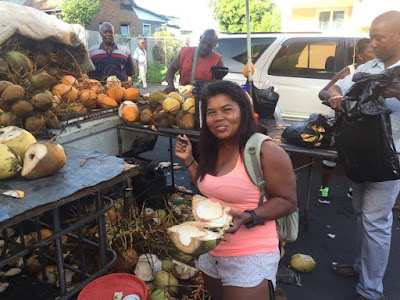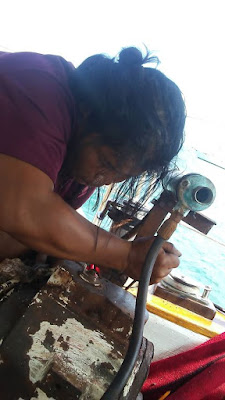 |
| On the dock with our belonging at Old Port Cove Marina in North Palm, Fl. |
But let me back up a bit. The last entry in this blog had us in Caymans. We have already detailed most of our stay there, so I won't say much more, but that after a week or so at gorgeous Little Cayman, Tropical Blend and Symbiosis moved back through the narrow cut and headed to Grand Cayman 90 miles away, We remained a number of days there before pointing our bows for Isla Mujeres, Mexico. It was a relatively uneventful passage, quite smooth with the usual combination of sailing and motor-sailing. A bit sloppy as we neared the Yucatan coast, but otherwise OK.
 |
| Symbiosis anchored at Little Cayman |
 |
| Our favorite photo of Symbiosis under sail. Thanks to Debbie Daigle of AfterMath. |
After Isla Mujeres, we made passage for Key West. Lots of squalls on that passage made it a bit unpleasant, compensated by a healthy boost we received from the Yucatan Current. For the first few hours, we were doing 7-8 knots at the starting line of the Gulf Stream.
Key West was fabulous. It was a nice re-entry back to our own home country, which has changed for the worse in so many ways since we sailed away in October 2015. At KW, we enjoyed the row of bars along the marina drag and explored the area, including the historic home of Ernest Hemingway, complete with the descendents of his famous mutant six-toed cats.
A few weeks previous, however, we had quietly listed Symbiosis for sale. It's possible you even saw our painfully honest ad on Facebook. Rather than haggle over every small detail, we decided to be perfectly up front about what the boat needed before being turned around and headed back to sea. We had long intended to sell her once we returned to the Chesapeake, but didn't know how long that might take. One thought we had was that if someone was interested in purchasing her along our planned route north, we might be able to incorporate a delivery into the deal. That's precisely what happened. We started communicating online with a gentleman in Florida who was interested. One thing led to another. He came to visit in North Palm and a deal was done on the same day.
So, now we are boatless. And homeless. And back on the Magothy River.
Did we "enjoy every minute" of our cruising? Hardly. But, we did enjoy nearly every other minute -- and frankly, that's not bad for us. It's a dirty little secret, but there's a lot of hard work involved in getting to paradise aboard a small boat. And, ever more rewarding for the effort.
Even so, I am sure that many of these friendships will endure. In mid-life, rarely does one develop such close connections with other adults. Cruising changes everything. There's a shared sense of the pleasures and the dangers of being on open water that the day-to-day soil-bound existence can't possibly fathom.
And, we can't even begin to express our thanks to the people of this wonderful region of the world who have shown us hospitality throughout our journey.
Finally, there is Symbiosis herself.
Of all the marinas in all the towns in all the world, she sailed into mine. That was a decade ago. Long before the Voyage of Symbiosis, she was my home and then a home for Noi and I. But we know we will never feel as strongly about a mere house. On this adventure and others before it, Symbiosis kept us safe and took us to some far corners that no airplane or giant cruise ship could ever manage. In total, we visited 15 countries, many of them twice, and that does not include the U.S. territories of the Virgin Islands and Puerto Rico. While we have yet to scrutinize our log book for an exact accounting, a rough (and conservative) estimate is that we put 5,000 nautical miles under the keel in the voyages chronicled here. Symbiosis, already a circumnavigator (as Argonauta, with previous owners), now has a circuit of the Caribbean to add to her pedigree. With her new owner, Andrew Falkenthal, it looks like she may cross oceans once again in a few years. Of the many floating hunks of fiberglass and canvas that dot this Earth, most are permanently leashed to the dock. But Symbiosis has lived up to the true meaning of what it is to be a bluewater sailor!
So, this is our final entry. I don't know how long it will live here, unattended in the ether, but it's our hope that others who might want to follow in our wake will discover something of value in this small estuary of the Internet.
From the crew of S/V Symbiosis, to you we say fair winds and following seas!
-- Scott and Noi, June 2017
scott_neuman@hotmail.com
 |
| Somewhere in paradise. Does it really matter where? |
































